Learning the Game - by Sachin Tendulkar | Prose | English - Reading | 9th English : UNIT 1 : Prose : Learning the Game - by Sachin Tendulkar
Chapter: 9th English : UNIT 1 : Prose : Learning the Game - by Sachin Tendulkar
Reading
Reading
Folk Culture and Folklore of Tamil Nadu
Tamil Nadu is deeply rooted in a great
tradition of folk arts and crafts, which display the customs and skills that
have come down from generations. The folk music and dances of Tamil Nadu
represent the ethos, aesthetic, values and melody of the region. Traditionally,
folk dances and music are performed during festivals and community functions.
The following article describes some of the folk musical styles and dances of
Tamil Nadu.
Karagaattam
is a popular folk dance of Tamil Nadu, which involves balancing a pot on the head to
musical accompaniment. The Karagam pots are decorated with a cone of flower
arrange-ments, topped by a paper parrot. The parrot swings as the dancer swings
along.
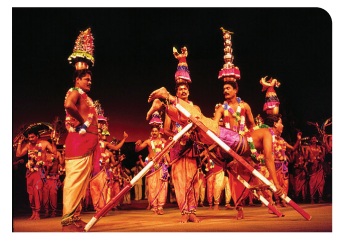
Karagaattam has two divisions — atta karagam
and sakthi karagam. This form of dance is very popular all over Tamil Nadu.
Both male and female performers participate in this dance. Acrobatics such as
dancing on a rolling block of wood, moving up and down a ladder, threading a
needle while bending backwards form a part of this dance.
Kavadi
Aattam is one of the predominant folk dances of Tamil Nadu.
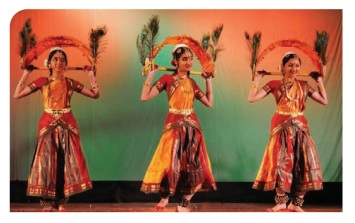
When the ancient Tamils went on pilgrimages,
they used to carry offerings tied on either end of a long stick, balanced on
their shoulders. A kavadi is made of bamboo strips and a light pole. To lessen
the boredom of the long travel, they sing and dance in praise of God. Kavadi Aattam
traces its origin to this practice. This led to the composition of special
songs for carrying the kavadi.
Poikkal
Kudhirai Aattam is a dance in which the dancer puts on the dummy
figure of a horse on his / her hips. This folk dance needs a lot of training
and skill. The dummy is made of lightweight materials and the cloth at the
sides of the dummy swings to and fro covering the legs of the dancer who dons
wooden legs so that they look like the hooves of the horse. While performing,
the dancer brandishes either a sword or a whip.
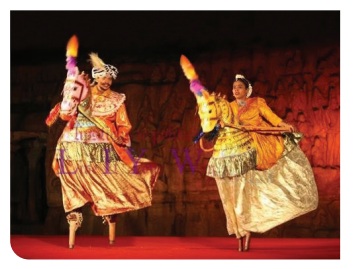
Parai
Aattam is a special type of dance in Tamil culture in which the
performers beat the parai and dance to its rhythm.
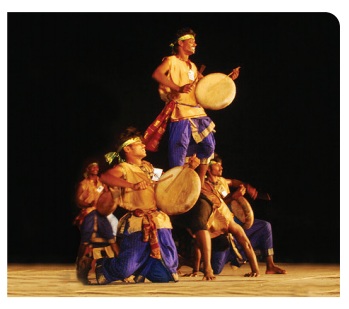
This is one of the oldest traditional dances.
In olden days, the parai was used for multiple reasons, ranging from warning
people about the upcoming war, requesting civilians to leave the battlefield,
announcing victory or defeat, stopping a breach of a water body, gathering
farmers for farming activities, warning wild animals about human presence,
during festivals, weddings, celebrations, worship of nature and so on. Parai
Aattam plays a prominent part in all the celebrations in Tamil Nadu even today.
Bommalaattam
or Puppetry is held in rural areas of Tamil Nadu during festivals and fairs.
Skilled puppeteers manipulate the puppets with strings or wires.
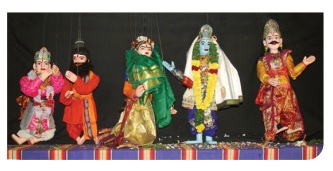
They stand behind a screen and the puppets are
held in front. The puppetry depicts stories mainly from the Puranas, epics and
folklore. Even during Indian freedom struggle awareness programmes for the
common people were conducted through puppet shows to instill patriotism among
the people.
Therukoothu
is usually
conducted during village festivals in the months of Aadi and Panguni. Theru
koothu is performed on the streets and in open air. In this dance form, make-up
and costumes are considered very important. The performance involves
storytelling, songs, dance and dialogue rendering. The performances are based
on stories from Puranas, Ramayana, Mahabharata and the local folklore.
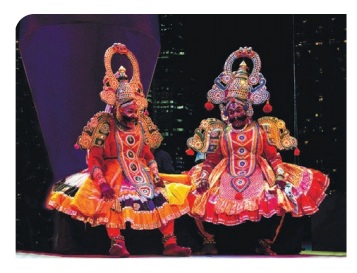
Silambaattam is a martial art form, practised from the days of the Tamil kings. It has metamorphosed into a non-violent form of folk dance, adding stepping styles into the dance to the measure of time. This martial art form also teaches the performer the methods of self-defense.
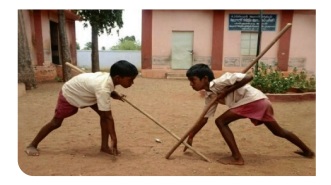
Silambam was banned in Tamil Nadu
during the British rule. Britishers viewed this martial art as a potential
threat in the face of revolts.
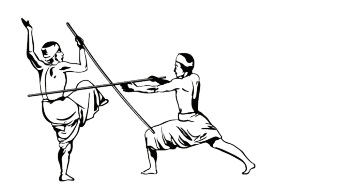
N. Answer the following questions briefly.
1.
What do Tamil Nadu folk dances and folk arts represent?
Tamil Nadu folk dances and folk arts represent the ethos,
aesthetic values and melody of the region.
2. When
are folk dances and folk music usually performed?
Folk dances and music are performed during the festivals and
community functions.
3. How
is Karagattam performed?
Karagaattam is performed by balancing a pot on the head. The pot
is decorated with a cone of flower arrangements topped by a paper parrot.
4. How
were offerings carried during the ancient period?
During the ancient period the pilgrims used to carry offerings
tied on either end of a long stick, balanced on their shoulders.
5. Bring out a few differences between the two art forms: Therukoothu and Bommalattam.

Therukoothu
i It is conducted during village festivals in Aadi and panguni
ii It is performed on the streets in the open air by the
artistes
iii In this dance form, make up and costumers are considered
importance
Bommalattam
It is held in rural areas during festivals and fairs
It is performed on the screen by the skilled puppeteers
The puppets with strings or wires are manipulated
Related Topics